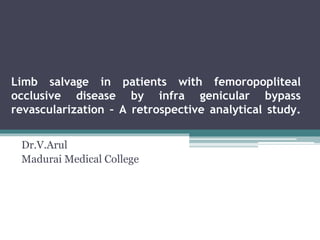INFRAGENICULAR-BYPASS-REVASCULARISATION.pptx
- 1. Limb salvage in patients with femoropopliteal occlusive disease by infra genicular bypass revascularization – A retrospective analytical study. Dr.V.Arul Madurai Medical College
- 2. Introduction • Femoro-popliteal occlusive disease frequently presents with critical limb ischemia in later stages • It usually doesn’t respond to early conservative management and eventually leads to amputation of the limb. • Limb salvage requires revascularization procedures • But only in 7% of the symptomatic PAOD, revascularization procedures are done, according to literature.
- 3. Why this study? • Revascular procedures are not performed routinely for the below knee occlusive diseases due to the • Technical difficulty to perform anastamosis in low caliber vessels below knee • Poor outcome after the infra genicular bypasses as per literature • Surgical treatment for TAO is limited • Our aim is to evaluate the role of revascularisation procedures below knee in limb salvage • And analyse their outcome in cases of femoropopliteal occlusion.
- 4. Inclusion & Exclusion criteria Inclusion Exclusion • Patients proven of peripheral arterial occlusive disease (by CT angiogram) •TAO •Atherosclerotic Occlusion • Patients with critical limb ischemia (ABI <0.9) • Arterial occlusion above the level of knee joint
- 5. Materials and Methods • Study was carried out in the Department of Vascular surgery, Govt Rajaji Hospital, Madurai , between Feb 2014 to Jan 2015. • 82 patients, proven of femoro popliteal occlusive disease (by CT angiogram) , with critical limb ischemia were taken in to study. • Initial presentation, Preop pain score, Preop ABI, Co morbid conditions, Level of occlusion in CT angiogram were noted. Preop Diagnosis was made.
- 6. Materials & Methods • Inflow vessel & Level of anastamosis (target artery) during surgery were recorded. • Patient was followed up after 6 months, and improvements in rest pain (Postop pain score), time taken for ulcer healing, post procedure ABI, duplex doppler are noted. • The results are evaluated using SPSS software.
- 7. Surgery – Femoropoleteal Bypass • Inflow vessel : •common femoral artery • superficial femoral artery •popliteal artery • Target vessel : •Anterior tibial artery •Peroneal artery •Mid posterior tibial artery •Distal posterior tibial •Distal popliteal artery
- 8. COMMON FEMORAL DEEP FEMORAL SUPERFICIAL FEMORAL POPLITEAL ARTERY POSTERIOR TIBIAL ANTERIOR TIBIAL PERONEAL ARTERY
- 9. RESULTS
- 14. Inflow vessel














